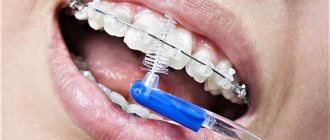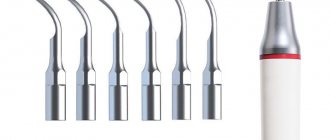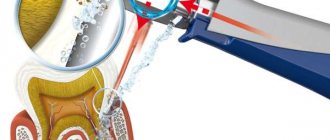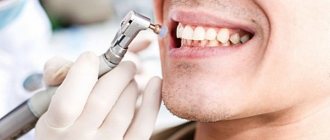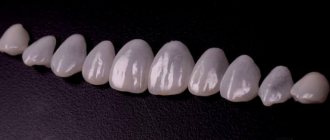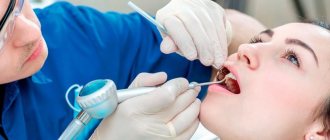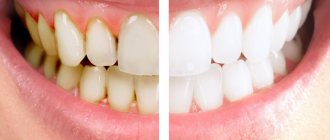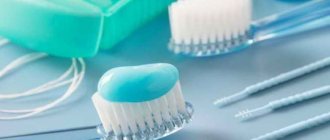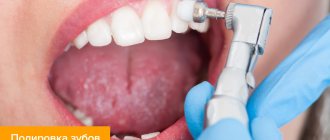Daily brushing and toothpaste does not guarantee that plaque will not accumulate, which is the main cause of tooth decay. There are several methods of professional hygiene, the most popular of which is ultrasonic teeth cleaning. Ultrasonic rays effectively destroy hard plaque without damaging the enamel. Today, experts advise ultrasonic cleaning to be carried out before any treatment or restoration, as well as as an independent procedure.
What is ultrasonic teeth cleaning
The main purpose of ultrasonic teeth cleaning is to remove hard deposits from the surface of tooth enamel. The so-called “tartar” is a mineralized plaque formed from decomposed food debris. But you shouldn’t think that stone can only occur in people who do not practice oral hygiene responsibly enough. It is impossible to remove all plaque with a regular brush, so the process of its mineralization occurs in absolutely all people. But, if a person smokes or drinks too much coffee or tea, then this stone becomes visually noticeable.
Ultrasonic cleaning is a painless and effective method. In addition, it is non-contact because the dentist's instrument (ultrasonic scaler) does not touch the teeth. This eliminates the possibility of scratches and other negative mechanical damaging effects. The scaler produces silent oscillations with a frequency of 16 to 45 thousand hertz. They are the ones who destroy mineralized deposits, crush them into tiny fragments, which are then washed off with sprayed water. The frequency level of the scaler is selected by the doctor depending on the area being treated.
Important: the procedure should only be performed by a qualified specialist using professional equipment in a dental clinic. Otherwise, there is a risk of harm to the health of teeth, gums and the body as a whole.
Advantages
Ultrasonic cleaning guarantees the following effect:
- removal of plaque and tartar,
- smooth and clean teeth,
- fresh breath,
- light whitening effect,
- prevention of caries,
- prevention of periodontitis,
- prevention of periodontitis,
- prevention of periostitis.
Teeth cleaning with ultrasound is an absolutely safe procedure, since tooth enamel is not affected during the manipulations and no mechanical impact occurs. Plaque peels off on its own under the influence of an ultrasonic scaler! Ultrasonic cleaning is not a whim, but a conscious necessity. Regular professional hygiene will help prevent the development of many oral diseases, keep your teeth healthy, your smile snow-white, and your breath fresh.
Many clients ask the dentist whether ultrasonic teeth cleaning hurts. The procedure is completely safe and does not cause severe pain, but in the absence of complete information about the condition of the enamel, it can cause significant harm to health. Before agreeing to a session, read the contraindications. The absence of these allows you to clean yellowed teeth without any problems. It is important that the procedure is performed by a certified specialist using proven equipment.
Indications and contraindications for
Indications:
- Pigmentation of tooth enamel
- Bad breath
- Bleeding gums
- Dentures (for correct selection of denture color)
- Before installing braces
- Before performing chemical bleaching of the enamel layer
Contraindications:
- Asthma, bronchitis
- Nasal congestion
- Severe cardiovascular disorders
- Installed pacemaker
- Any disease in the acute stage
- Epilepsy
- Serious neurological pathologies
- Age up to 18 years
- Presence of implants, crowns, “bridges”
- Purulent lesions of oral tissues
How long does the effect of the procedure last and how often should it be performed?
Patients and specialists note that the maximum duration of the effect after ultrasound treatment lasts about a year. The same time is enough to restore the enamel layer. Therefore, after a year the procedure should be carried out again. At the same time, doctors recommend that patients with a tendency to pathological plaque mineralization perform enamel cleansing with ultrasound every 6 months. You can determine the required frequency of dental hygiene yourself. If, immediately after regular daily brushing, your teeth look something like this photo on the left, then the need is ripe and it’s time to make an appointment with the dentist.
Advantages and disadvantages of ultrasonic cleaning
Advantages:
- Possibility of removing plaque even in interdental spaces
- Elimination of dark pigmentation from tobacco and food colorings
- Removing deposits from periodontal pockets
- Sterilization of the tooth surface from pathogenic microflora
- Lightening enamel to a natural shade
- Prevention of caries
- No risk of injury to teeth and gums
- Eliminates unpleasant odor caused by deposits
Flaws:
- Discomfort when treating sensitive areas (periodontal pockets)
- Increased sensitivity of enamel to hot and cold stimuli for several days
- A large number of contraindications
How to prolong the effect of ultrasonic cleaning
Ultrasonic cleaning is recommended once every six months. To ensure that you always enjoy clean and healthy teeth, you must adhere to the following recommendations from your dentist:
- refrain from consuming coloring products for 5-7 days after the procedure,
- brush your teeth thoroughly, incl. dental brush,
- use mouthwash
- eat apples, cucumbers and other natural “cleansers” of teeth,
- If you are hypersensitive, you should avoid eating sour fruits and juices, chips, and foods with sharp edges immediately after the session.
Stages of the procedure
Ultrasonic cleaning is a serious medical procedure and is therefore performed according to an approved protocol. First, the doctor visually examines the patient, determining the degree of contamination of the enamel layer. Then - a mandatory medical history. This allows the doctor to identify possible contraindications. If the patient has hypersensitive enamel, then local anesthesia is given. After this, the cleansing itself begins. The power and other settings of the device are selected by the dentist based on the specific clinical case. The next stage is grinding the ultrasonic-treated teeth using a drill and a special attachment, or manually. In conclusion, the doctor recommends covering the enamel with fluoride varnish to strengthen it and reduce sensitivity.
Note: experts recommend that after ultrasonic removal of tartar, you undergo a professional Air Flow cleaning procedure. This will not only allow you to ideally remove remaining soft deposits, but also make your teeth visually lighter by 1 – 2 shades.
What is the result of ultrasonic cleaning
The method of removing tartar using ultrasound is considered the safest, painless and fastest. The result of this cosmetic procedure will be healthy teeth and oral cavity, a snow-white smile and fresh breath.
Ultrasonic teeth cleaning is a professional removal of tartar and hard deposits using special equipment that generates ultrasonic vibrations.
What can the formation of tartar lead to?
The formation of tartar can lead to quite unpleasant consequences:
- the gradual deposition of hard plaque in the pregingival and supragingival areas leads to diseases of the oral cavity: caries, gingivitis, periodontitis and other diseases.
- infectious diseases, in turn, cause bad breath, bleeding gums, destruction of enamel, and in especially advanced cases, tooth loss
- During pregnancy, serious oral diseases can harm the health of not only the expectant mother, but also the child.
How can ultrasonic teeth cleaning help?
All this can be avoided thanks to ultrasonic teeth cleaning. And that's why:
- During the procedure, tartar, which is the cause of many oral diseases, is completely destroyed.
- The oral cavity is disinfected - not only in the places where the stone is removed, but completely.
- teeth become 1-2 shades lighter. Devoid of plaque, they regain their natural, original color.
- the effect of clean teeth after removing hard plaque with ultrasound lasts steadily and for quite a long time (unlike, for example, the mechanical method of removing stones).
The effect of ultrasound on dental tissues leads to high susceptibility to fluoride prophylaxis. If done immediately after brushing, this procedure will provide significant additional protection for your teeth.
What happens before cleaning
Ultrasonic teeth cleaning, before and after which you will have to perform certain actions, is a very effective procedure.
So what's the "before"? Preparation for professional teeth cleaning is carried out directly in the dental office, and involves antiseptic treatment of the oral cavity with disinfectant solutions. Then a special gel that conducts ultrasonic waves is applied to the teeth. And only then the doctor begins to directly clean the teeth using a special device - a scaler. The whole process takes about 30-40 minutes.
What to do after cleaning
But correctly performing the stage “after” ultrasonic removal of tartar will be “homework” for the patient himself. If you want to keep your teeth clean and bright for as long as possible, then for several days after the procedure you need to exclude bright juices, coffee, tea, carbonated drinks, fruits, red vegetables, chocolate and other foods with coloring substances from your diet. You should also refrain from smoking. And, of course, to maintain long-term results, you should maintain oral hygiene and regularly visit the dentist, including for repeated ultrasonic cleanings.
Expert opinion
The result of ultrasonic teeth cleaning depends on two important points.
Firstly, this is the quality of the equipment with which the procedure is carried out and the qualifications of the doctor who performs it. You need to choose a clinic with a good reputation, modern technology and competent specialists. Secondly, the patient himself can influence how to maintain the oral cavity in good condition for as long as possible after professional cleaning. This requires careful personal oral hygiene. First of all, you need to choose the right toothpaste, using high-quality products with a minimum content of chemical compounds and abrasives. Don't forget about dental floss and rinsing with antiseptic agents. It should also be taken into account that the procedure for removing stones must be carried out at least once every six months.
Oral care after ultrasonic cleaning
Dentists recommend adhering to the following tips:
- In the first 3–4 days after the procedure, teeth should be brushed after each meal and at night. In this case, you should not use abrasive toothpastes, as this can irreversibly damage the enamel layer. You should also change the old brush, as pathogenic bacteria remain on it, and the enamel is overly vulnerable during this period;
- reduce in your diet foods and drinks containing natural and artificial colors (tea, coffee, berries, etc.). This rule should be followed at least in the first week after the procedure;
- increase the number of foods that are sources of calcium in the menu;
- avoid sudden temperature changes, for example, after hot tea you should not eat ice cream;
- in case of possible injury to the mucous membrane of the gums, they should be treated with antiseptic healing ointments, rinsed with a warm chamomile decoction;
- If inflammation occurs, consult your doctor immediately.
The dental network offers ultrasonic teeth cleaning services. Our clinic offers family and savings discounts. Our doctors are highly qualified and continue to improve their skills in leading Russian and European dental clinics. The level of our medical services meets international standards.
Branches of our orthodontic center are located in Moscow within walking distance from the metro:
- Art. Alekseevskaya (VDNKh district, etc. Mira), address: st. 3rd Mytishchiskaya house 3, building 2;
- Art. Shelepikha, address: Shelepikhinskaya embankment, address: building 34, building 1.
We will help keep your teeth healthy! We are waiting for you in our clinic every day without breaks and weekends.
The essence of the method
Compared to mechanical or chemical methods of teeth cleaning, this procedure has the main advantage: safety. Tartar is quite difficult to remove using mechanical methods, which can damage tooth enamel. When using ultrasound, tartar is easily separated, and the enamel is not damaged. In this case, the procedure will be comfortable for the patient and usually painless (in some cases it is recommended to use anesthesia - for example, when removing subgingival plaque).
For ultrasonic cleaning of teeth, a special device is used - an ultrasonic scaler. First, the surface of the patient’s teeth is covered with a special gel, which is then exposed to this device. Under the influence of ultrasound, the gel releases oxygen, which oxidizes deposits. Thanks to vibration, not only the tooth surface is cleaned, but also the periodontal canals. Using this method, you can even get rid of stone that forms under the gums. After completion of the procedure, the enamel is polished and a fluoride-containing composition is applied. The entire session lasts about an hour.
Typically, ultrasonic cleaning is carried out in combination with other methods of cleaning the oral cavity (for example, Air Flow). This service is also available in our clinic. The procedure is recommended before treatment and teeth whitening, as it provides disinfection of the oral cavity, a better view of enamel defects, and stronger adhesion of the filling material.
